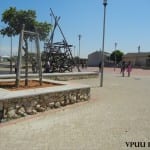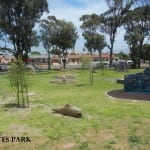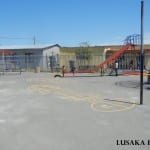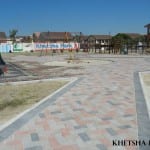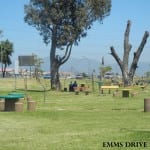Scene 3: Cape Town Park Tour
12 November 2013
Backstory:
One of the steps we planned to take when arriving in Cape Town was to get out to different parts of the city and see how parks in Cape Town are implemented, used, and treated. We considered this to be an important step in our process of redeveloping Perseverance Park for two main reasons. The first was that while we may have an understanding of parks in the United States and the types of parks we see every day; Cape Town is not like our own homes. There is a difference in culture and a different set of needs that should be met by parks in Cape Town compared to the US. The other reason we went on this tour was to see the possibilities other parks in the area had to offer and show them to our co-researchers. The tour was to be a starting point for brainstorming ideas for Perseverance Park and a stepping stone for the design of the park.
Cast of Characters:
WPI Team: Lucine, Tyler, Katherine, Zack
Co-researcher: Abdul
Community Members: Ronell
Parks Department: Jude Carolissen
Van Driver: Neville
Various City of Cape Town Park Project Managers
Setting: Cape Town Parks
Queen’s Park
Nantes Park
NY10 Play Park
Emms Drive Park
VPPU Park
Lusaka Park
Khetsha Park
Manyanani Peace Park
- VPUU
- Queen’s
- NY10
- Nantes
- Mayanani
- Lusaka
- Khetsha
- Emms Drive
Scene:
Today, though a normal Tuesday for most of the other groups started off much differently for us. Today we would go on a tour of various parks throughout Cape Town to better understand the kind of work possible here as well as promote the flow of creativity for design. Originally this tour was to happen much sooner after arrival in Cape Town, but some unforeseen mechanical troubles prevented the Parks Department from taking us around. In true CT Project Center fashion, setbacks and sudden changes are expected and we secured our own transportation for a different day to accommodate for a large group of expected attendees. This was the first time we left the lodge to get into a passenger van instead of walking to the train or taking a taxi out to Garden Village. By 9:00AM we were in the van and on the road to Garden Village to pick up Jude, Ronell, and our co-researchers ready to take pictures, notes, and open our minds to the possibilities a park can hold.
The first stop on our journey was to the City Parks Depot in Khayelitsha to pick up Jude’s equivalent in that district. After introducing himself to us he was rearing to go to the parks he manages. Our first stop was to Manyanani Peace Park. When we arrived, there were large hoses set up with sprinklers going across a third of the park, providing water to the newly growing grass. The park was fairly old, with play equipment and structures that were not entirely intact, but the park is open and has a good amount of trees spaced throughout. A path beginning at the entrance to the park leads us by a stone amphitheater surrounded by a low hill around half the stage where people used to gather and watch performances. Benches and bench table combinations were spread throughout the space and under trees providing a shady place to sit and enjoy the day.
The next stop on our tour was to Khetsha Park. The first sight of this park was that of many construction workers putting up a steel palisade around the park. Our guide then explained that this park is in the process of being upgraded and improved; a process which began as a community driven initiative. We walked in through a gap in the fence that would later serve as an entry point for the park to see a new wooden jungle gym play structure and several other items. Another noticeable eye catcher was the paving stones marking the new entrance to the park as well as occupying the central part of the park where more seating would be installed. The far wall was being painted with brilliant colors, the name of the park and other murals including the Cape Town logo.
To see a park midway through upgrading was interesting for us, because we could see the mix of new equipment and old features that would be incorporated into the park, but did not quite fit in yet. The turn table looked dull and old compared to the vibrant colors of the murals and new climbing structure, yet it worked just fine. This is something that would undoubtedly happen to Perseverance Park. It takes time to redevelop all aspects of a park and it can’t all happen overnight. Hearing that Khetsha was a community driven development showed us that with community support and drive, even a long process of upgrading can happen.
Moving on from Khetsha we went to another park in the area called Lusaka Park. This was one of the more unique parks in that it was almost entirely paved. The only part that did not have a concrete ground was a narrow border along one of the sides in front of the fence which was planted with flowers. The ground covering offered the opportunity to play games on the ground such as hopscotch. Two different hopscotch boards were painted onto the ground in the middle of the park which a few children who came into the park began to play on. The standard slide, turn table, and stone benches were present in this park as well, offering a clean area for people to sit and for children to play.
The last park we visited with the City Parks manager from Khayelitsha was a VPUU (Violence Prevention through Urban Upgrading) Park in Khayelitsha. It was explained to us that the funding for this particular project came from a German national bank which allowed for a serious upgrading to occur. The area the park occupies is part of the path people take from the train station into the township and most of the other areas. This was reflected by the line of many light posts along a stone paved strip of the park. Other than the paved area we noticed a green space for soccer as well as many trees planted within benches that would one day grow into beauties providing shade. There is a building that was constructed along with the park’s creation which houses a caretaker whose sole job is to maintain the park. This building appeared to also act as a community facility as well, which was two stories high allowing for a more comprehensive view over the area. One of the features the building overlooked was a large climbing structure which was quite different from the ones we saw in the other parks. From a distance it appeared to be large pile of sticks, but upon closer inspection we could see that it was created out of many pieces of timber that were not uniformly shaped. They curved and bent in ways that gave every part of the structure a unique experience. The structure was very natural in its design and contrasted sharply with the large amount of stone paved surface throughout the park.
For the next two parks that we would visit we were joined by a different member of the City Parks Department. He brought us to Emms Drive Park as well as NY10 Play Park. Emms Drive occupies a small width of space between two roads, but continued down the length of the roads for quite a ways. There was no play equipment in the park but it did have a lot of seating in the form of benches and tables. Almost all of the seating was the round cement formed benches and stone table, but there were a few concrete and wooden benches spread throughout the area. The City Parks worker mentioned that he was surprised the wood on the benches had not been stolen yet. There was no formal barrier on either side of the park, but rather thin cement cylinders on the edges to prevent cars from driving into the park. It looked like there had once been a lot of shade in the park, but many of the trees had been almost completely cut down leaving the area bare and very open to the sun.
The second park, NY10 Play Park had seating and play equipment as well as being much larger than some of the other parks we had already seen. Because it was much larger there was more landscaping and ground elevation changes possible. We entered the park at one of the higher points and the first things we saw was a large raised platform on which a chess board was painted with plastic chess pieces sitting in one corner. This was the first time we had seen anything like this in the parks we had visited and we immediately went to investigate it further. The chess pieces are brought in everyday in the afternoon and then taken back in the evening, keeping people from stealing them despite the park being open 24hrs a day. The four sides of the platform had murals painted in bright colors of flowers, cars, trains, planes, and other images.
From this platform we could see the rest of the park and spread out to investigate what this park had to offer. The park had many formalized paths made of red clay spanning from one end of the park to the other, bordered by flower beds or trees in many places. Following one of the paths down the slight hill lead us to the area of the park dedicated to different play equipment. There were two slides, two jungle gyms, a seesaw, and a turn table all of which were the same standard items in most of the parks we saw. On the way to the play equipment we could see that one corner of the park was occupied by a paved court for both basketball and netball. This was the first park we saw that day with an area specifically dedicated to this. While the park had a lot to offer in terms of seating, they were not in the best of conditions. Tables were missing tops and some of the benches were broken in half or almost entirely reduced to pieces. The seating is also not in places that will receive much shade so people that were visiting the park were sitting up against a tree here and there to avoid the hot sun. Looking at the park as a whole we did not see too much green, but rather a dull brown green mixed with the red clay paths running throughout the space.
Leaving NY10 behind us, we continued to travel through parts of the city we had never seen before to reach what would be our second to last stop and one of the greenest parks we have seen in a while. Nantes Park was this stop and it was here that we saw so many of the positive elements of park design which we learned from the research we did during our preparation term. Upon our arrival we were welcomed by the front gate of the park, which was not just a metal fence but a structure. It appeared to have offices and rooms within but the most striking park about it was the tile mosaic which covered the majority of the wall. This mosaic depicted the story of how Nantes Park came to be and how it got its name. To either side of this front entrance spanned long stretches of steel fence, but rather than the cold metallic looking palisade fencing, it was the more expensive green painted steel link fence which blended in with the park. Seeing a more visually appealing fence added to our already heightening hope that this park would be a great space.
Once entering the park we could see many trees, a rolling landscape with variations in height and theme, and structures that incorporated a natural feel and design. As soon as we entered we could tell that we would not be able to see every corner of the park since it was too big to even see all the way to the other side, but we were not discouraged from trying. The varied landscape added a feeling of wonder as we explored what would lie on the other side, eager to find more examples of park elements we could bring back to Perseverance Park. We sat down to eat a quick lunch at a round pavilion attached to the entrance building under the shade of a wooden canopy.
At this point the four of us and our co-researcher went our separate ways to explore what the park had to offer. Abdul, Lucine, and Katherine focused on the park equipment for the kids and seating for the parents while Zack and Tyler went off to see different parts of the landscape and observe the more open, green spaces. In the end we came together with a large collection of pictures and ideas about how a natural park looks in Cape Town.
Reflection:
In looking back at all the things we saw, the entire day was extremely productive and informative. We not only learned about what some other parks had to offer in terms of equipment, but also in the management of the spaces. Many of the parks were fenced in and closed at night, which does not coincide with our research that well but it does have its benefits. These parks tended to be cleaner and well maintained. Just about all of the parks we came across had some kinds of caretaker or a team of community members whose responsibility is to keep the park clean and orderly. We fell in love with the natural environment provided by the Nantes Park which meshed so well with the ideas and concepts we hoped to bring to Perseverance Park, but we also saw some things that were less pleasing. The almost entirely paved Lusaka Park was clean, well maintained and well used by community children, but is not the safest materials to cover the ground. What was pleasing, was to see community members and children visiting this play space and enjoying the safety and comfort of it.
We were able to engage with Ronell and Abdul in conversations about park design and elements and also have fun with the experience. We took the opportunity the parks presented and explored the environment and played on the structures available. It was a great chance to become closer to the two of them through a productive day where we all learned something which we could take back home with us.



